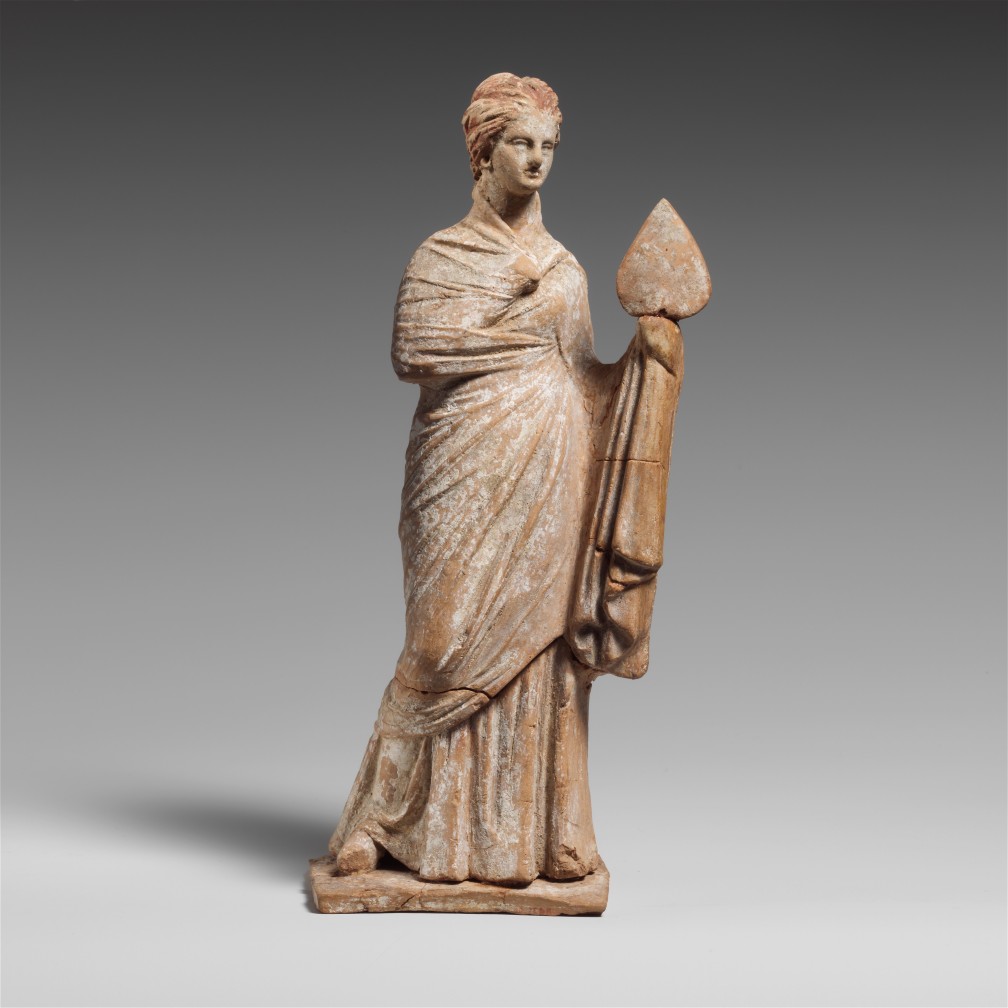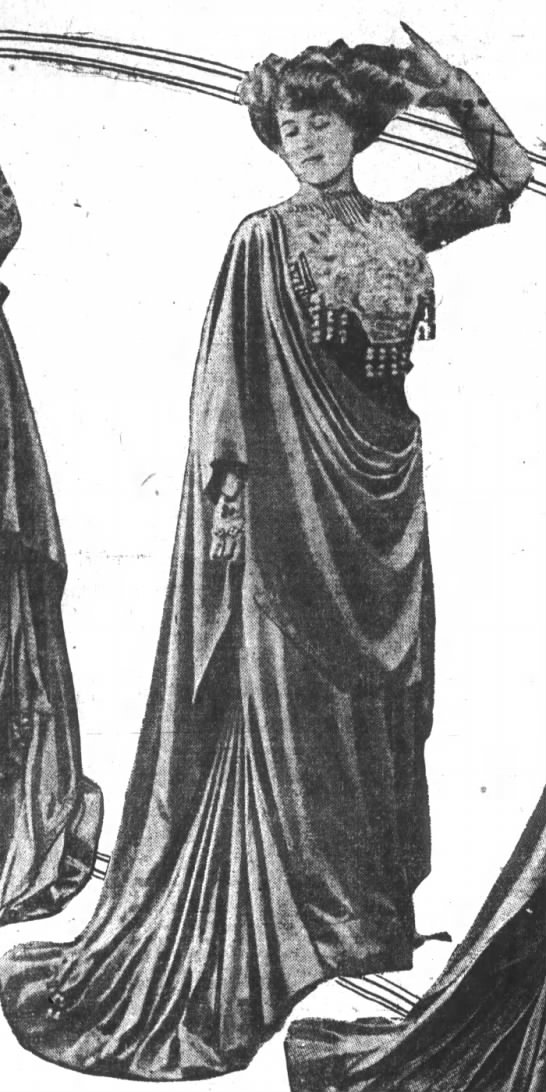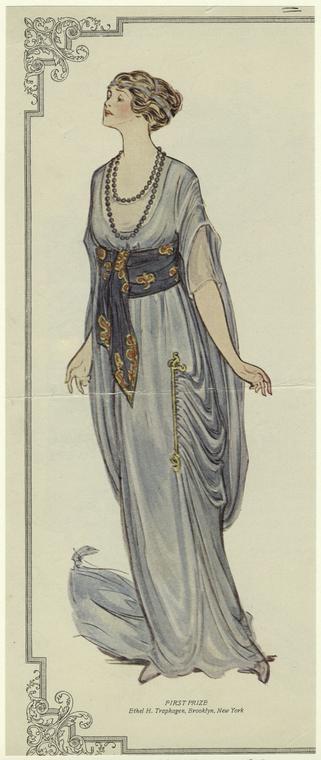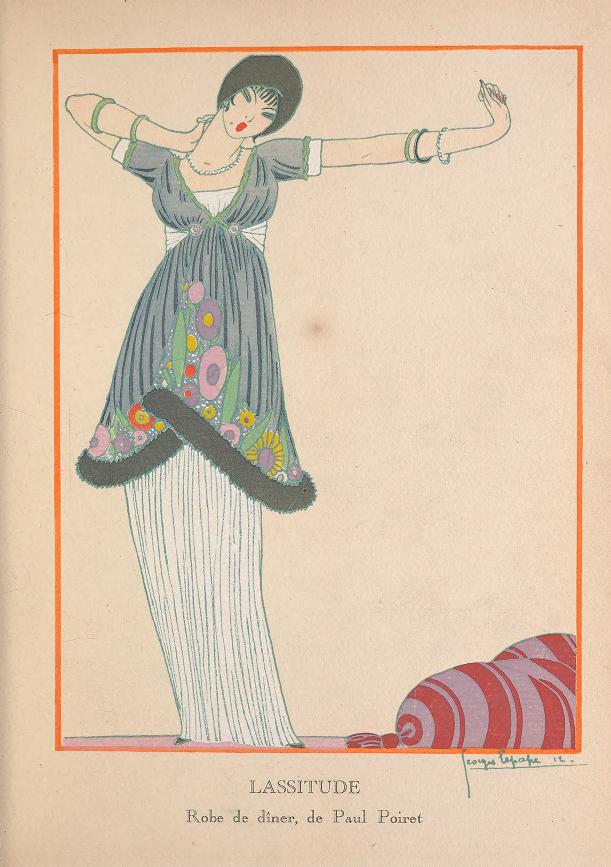
Tanagra figure from the Metropolitan Museum of Art
Paris fashions from the spring of 1908 had flowing lines and lacked a clearly defined waistline. Restrictive corsets were no longer needed.
A Strawbridge and Clothier Department Store advertisement, Philadelphia, PA, dated 19 March 1908 heralds the New Style:
“Paris—marvelous Wizard of Dress! More wonderful now than ever. Her magic has conjured beauty from all ages for the Fashions of Spring, 1908. She has studied Greek statues and Tanagra figurines and learned the art of classic grace of line, flowing draperies and tunic bands. She has pored over picture and story of Napoleon’s court, and retains the raised waistline typical of Empire gowns. From the Directoire, she has borrowed cutaway fronts, waistcoats, lace jabots and skirts sheathing waist and hips. She has studied the ancient treasure turned up by the archaeologist’s spade in Egypt for ideas for garnitures. She has revived the embroideries of ancient Byzantium. She has duplicated old Italian, French and Spanish laces. She has gone to Africa for the Algerian sash and the Egyptian alme’s scarf. And the sash and scarf are the sartorial sensation of the Spring in Paris!”
The Exposition of Superb Gowns from Paris was held in the Dressmaking and Tailoring Salon, 3rd floor, East. Gowns, tailored coats and costumes from famous Parisian designers such as Doucet were modeled. The dressmaking salon could recreate a desired costume custom fit to the client.
By December of 1908 even the rather more conservative Mrs. Osborne, who wrote a dressmaking and fashion column for the magazine, The Delineator, was taken with the colors and fabrics of the new Paris fashions. She was very impressed by “the colors of the present year. Nothing more exquisite, more absolutely satisfying to one’s craving for beauty, could possibly be imagined. There are shades of rose color, wisteria and ashes-of-violets that one could almost rave over. The new amethyst dye might inspire an artist, and the revival of bottle-green has an old-world quaintness faintly suggestive of Beau Brummels and highwaymen and other delightful events and personages of the picturesque past.
Yet is it not true that our pleasure in these rainbow colors is sharpened materially by the knowledge that we have but a short time for their enjoyment? The rose and the violet will be superseded by other flowers; bottle-green is sure to become popular and will, therefore, cease to be smart. Even the dull reds and blues and tarnished silver that we have borrowed from old tapestries will seem trite tomorrow. So while they are with us let us enjoy them thoroughly and dismiss them philosophically when they go. Personally, I shall have a lingering regret for the dull powder and mist blues that are just beginning to be worn, the soft, dark mulberry-red and the more emphatic Virginia-creeper crimson.”
On 31 December 1908, Wanamaker’s Department Store in Philadelphia looked back at important events of that spring:

The December 1908 Delineator provided an illustration showing three styles of dress: one with a lowered waist; one with a raised waistline; and one with a draped sash.

Underneath the gowns “the sheath-fitting skirts and carefully designed princess gowns necessitate underwear that is as faultlessly fitted as the dress itself. To this end, women are extremely critical and careful that the under-garments shall be without gathers, folds or any sort of extra fullness above the hips. And not only is the dress in one piece, but an undergarment which combines corset cover and skirt in princess style is a most desirable one to wear with these sheath fitting gowns.”

Another option to a separate corset or an unstructured corset cover and skirt combination might be a corset incorporated within the gown. Mrs. Cholly Knickerbocker wrote a fashion column about the new “Frenzied Fashions” on 22 November 1908:
“New Tanagra Gowns with Corsets Sewed Into Them”
“Think of corset and gown in one! But this latest clever thought is not inexpensive. Only the most skilful of stay-makers are employed to make the corset, which is fashioned of the lining of the frock. He builds it absolutely as he would an ordinary corset, following the measurements carefully. When completed it is returned to the modiste, who then proceeds to build the gown upon it.
And such a perfect fit as results! It means a corset for each gown, as the dress is actually made and sewed upon it, but for those who can afford it it is a luxury worth considering. It reduces the underclothing to a minimum. The greatest dressmakers all agree that even the lightest corseting spoils the svelte lines demanded by these artistic frocks. The graceful droop at the waist, the lax pose of the figure, the languid air of the whole silhouette is best obtained when few underclothes and no corsets at all are worn.
This does sound a bit startling at first, but it is an actual fact, that with some of the more extreme of the new Grecian and Tanagra costume effects the corset will be dispensed with altogether. In its place will be worn a little contrivance—or rather two contrivances—of satin, which, while giving the necessary support at the bust and keeping the figure flat below the waist in front, will leave the wearer absolutely free and unhampered at the waist line.”
The Tanagra Gown

The interior of the Tanagra gown as described by Mrs. Cholly Knickerbocker.

In the well known and now very affordable book, Couture Sewing Techniques (First Edition), author Claire Schaeffer describes the construction of a built-in corselette.
In this video designer Tony Ward fits the corset to the form and builds the dress upon the foundation.
In 1913, five years after the advent of the New Styles from Paris, the fashion silhouette of 1908 had been only slightly modified. The waistline, if defined at all, was wider and more like an obi or sash. There was still no need for strictly restraining corsets. If corsets were worn they were made of the new elastic material or had few bones. A news story from June 1913 is titled: “Classic Lines Influence Fashions” and it is noted that “the cultivation of natural figure lines is frequently referred to as a revival of the classic proportions associated with antique Greek sculptures or with the unconfined lines of the belles of the First Empire.”
The prize winning Blue Gown of 1913 designed by Ethel Traphagen

https://digitalcollections.nypl.org/items/510d47e0-ef23-a3d9-e040-e00a18064a99
The Gazette du Bon Ton magazine has many lovely fashion illustrations dating between 1912-1915 including this illustration by Georges Lepape of a dinner dress from 1913 by Paul Poiret. The link to the 1912-1913 copy of the Gazette from the Smithsonian Library is below.

http://library.si.edu/digital-library/book/gazettedubonton00
References:
Tanagra figurine
http://www.metmuseum.org/art/collection/search/247581
The Delineator, December 1908
https://catalog.hathitrust.org/Record/000545715
Also in this issue of the Delineator on page 946 is the article “Dressmaking Made Easy–How to Make the Fitted Waist”, by Eleanor Chalmers. The waist is lined and boned and the proper placement for cutting out of the pattern pieces is shown.
Another well researched posting, Carol. I love the evolution towards the 1920s that is taking place here. Little by little the awful distortions created by corsets were going away. It was a very slow process but I can see it here. Do you, too?
LikeLiked by 1 person
Yes, I can see now how early it started, Em. I had read earlier that the 1909 Ballets Russe performance in Paris sparked the trend to less restrictive dress. The news clips from the spring of 1908 suggest the new styles from Paris were an exciting and welcome change that persisted throughout the teens, into the twenties, and beyond.
LikeLiked by 1 person
Yes! The Ballets Russe and Erte’s sylph-like drawings. I love the colors described in the news clipping you posted. They seem haunting and appeal to me greatly. I do think a complete change of make-up and hairstyling would be required if I used such colors today.
LikeLiked by 1 person
It’s lovely to see the end of those restrictive corsets and I love the Paul Poiret dress.
LikeLiked by 1 person